|
Know anyone who
can benefit from
this? Share! |
|
|
 |
 |
 |
 Want more articles? Go
here
Want more articles? Go
here |

Bike Sizing Before Purchase
What you should do
to buy the right bike model and size for you
Bike sizing is very likely the most important decision you
can make before buying a bike - any bike, new or used.
Will this bike fit me? Is this the right bike for me?
Will it work for what I want it to do?
| These are key questions you need to ask
yourself before buying a bicycle.
Knowing what works and what
doesn't will help you choose among the bike that fits and the
one that never will.
The process of bike sizing
takes subjectivity out of the equation and cuts through
the marketing hype to help you find a bike that fits you, your body and your budget.
WHY IS PRE-SALE BIKE
SIZING NOT FOUND AT THE BIKE SHOP?
Can you trust a bike shop to size
you correctly?
When sales are intertwined with
bike sizing, the answer is likely: "NO".
You probably have noticed that the
bike shop is no longer the source of cycling knowledge
it used to be. Pricing pressure from the ever-present
internet dealers have caused a race to the bottom line.
Bike shops can't sustain this
price pressure while employing knowledgeable personnel.
Bike shops also have a reputation
for selling what needs to be moved off the floor without
regard to actual fitting.
They can't invest in expensive
bike sizing equipment and can't devote the time to
the process. They need a quick turn around to stay in
business.
The solution is to look for a
service that's independent of the sales process and
focuses on your success only.
With no stake in the sale
and margins, a bike sizing session is your best
ally.
CAN'T I JUST
FIGURE IT OUT MYSELF? AREN'T SIZING CHARTS PUBLISHED?
Yes! Bicycle manufacturers publish
sizing charts to help you choose. And, definitely, you
should learn all you can about the bikes on your
shopping list.
But things got really complicated.
Bikes are a marvel of engineering and today's geometries
are as complicated as they are variant.
It used to be that a quick glance
at the top tube and seat tube length and you had your
size. That's no longer true. Sizing charts are a marvel
of engineering data that reveal the true nature of a
bike - if you can understand them in their entirety.
Each bicycle manufacturer has a
geometry design philosophy that reflect its belief in
how a bike should look and handle.
And each manufacturer has its own
sizing standard. You may be a 51 in one brand, 52 in
another and 54 in yet another.
How do you know which is which?
The bike sizing process
cuts through the noise of the marketing hype and helps
you find the right model, size and geometry - completely
agnostic from the brand.
It will help you decide if a bike
on sale is worth purchasing or not.
With the information from
bike sizing, you will save you a lot of money and
even more aggravation. You'll find the ride of a lifetime.
HOW ABOUT AERO
BICYCLES WITH INTEGRATED COMPONENTS?
This is where bike sizing shines.
It finds out the size of all these sophisticated and
highly proprietary aero integrated components ahead of
purchase.
In 2018 most manufacturers moved
away from standard, interchangeable components and went
on to each have proprietary parts: stems, handlebars,
seat posts.
Since they are new at this, there
has been a shortage of aftermarket proprietary parts
simply because the manufacturers were caught unprepared
in their forecasting of the production of these parts.
2020 saw this trend become even
more exacerbated.
So, it's very important to know
what components you need, so you can check the
availability before making the decision to buy a
specific model. You don't wan to want a year to get the
rights parts to ride your new bike.
What's your stem size? Do you need
a 0 offset or setback seat post? Crank length?
Modern aero bikes have expensive
one-piece barstem cockpits. Integrated with hydraulic
brake lines and electronic shifting, these handlebars
are a task to remove and replace. Typically, the
replacement of an integrated barstem runs between $700
and S1000, with nearly half being labor.
Aero seatposts are proprietary to
each model. The setback is key to your pedaling
efficiency. At a replacement cost of $300+ and often
long ordering times, you want to make sure you know what
seatpost you need before taking delivery of an aero
bike.
Bike sizing will determine
the size of all proprietary components ahead of the
sale, so the bike can be delivered to you with the right
sized components and you don't have additional,
unexpected expenses. |

Bike sizing is done aboard a special technology: the
sizing bike. Our sizing bike replicates any bike, any size any
geometry. You are fit aboard it, just like the actual
bike. You'll be able to feel it pedaling under a smart
trainer load and tell if a certain bike size and design feels good or
not. |

The complete sizing chart for a Trek Madone. Lots of
information that has major repercussions on your bike
fit. |
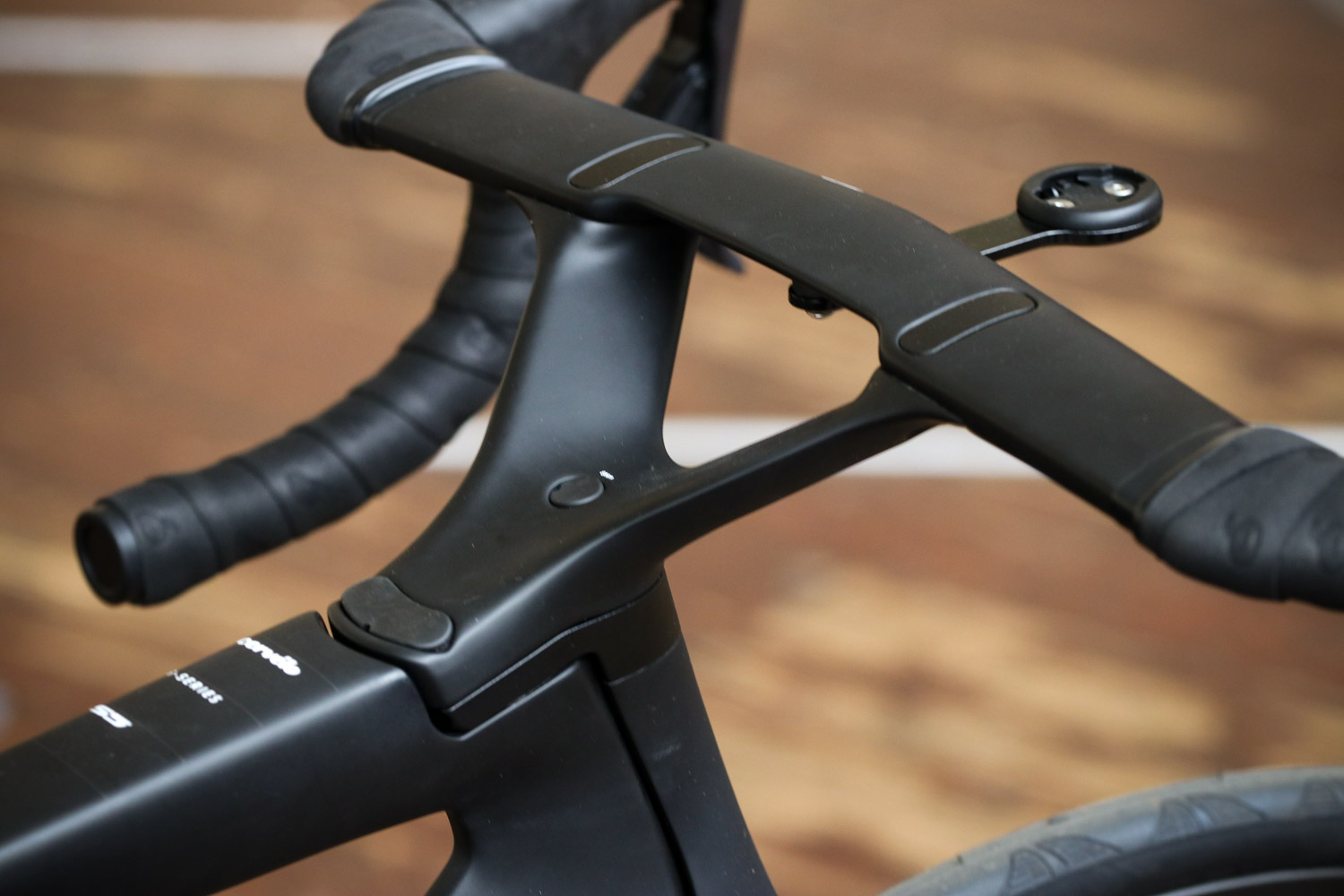
The integrated barstem of a Cervelo S5. Hydraulic brake
lines run inside. Brakes must be disconnected and bled
to replace. It's a big job! |
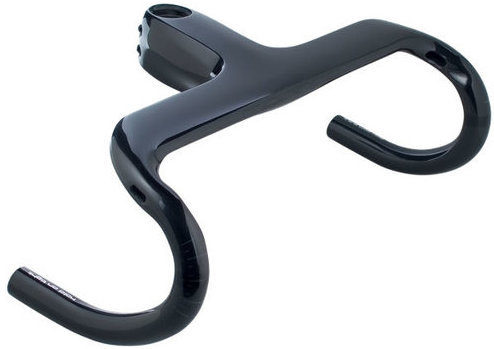
The barstem of a Trek Madone. Shifter and brake lines
run inside and through the headset bearings. It can be a
3+ hrs job to replace and re-run these lines just to
change the stem length! |
WHAT AM I LEARNING FROM THIS
ARTICLE?
In this article we cover a wide-range of
topics to help you make sense of the sizing process and decide
if you need it for yourself.
- Who can benefit from from
bike sizing?
- Why should you know your
size, geometry and components size before going to a
bicycle store/shopping online
- When a sales is not a good
deal?
- How are bicycle designed
in sizes?
- How's the process of bike
sizing done?
- Do I ask the right
questions to select the bike that's right for me?
- What's my application?
WHO SHOULD GET SIZED?
Everyone buying a new or used bike should
get sized. Knowing the right bike size is the most powerful tool
in your purchasing process. It's often given for granted you
know your size or someone could tell you just by looking at you.
Often, it's expected that a little variation would be OK; you
can adjust to the bike if it's a little too big or small.
But that's not true. Size matters. To
everyone. From the weekend warrior, to the recreational path
rider. On a modern bike, you can be only one size. Period.
Right bike size = comfort and performance.
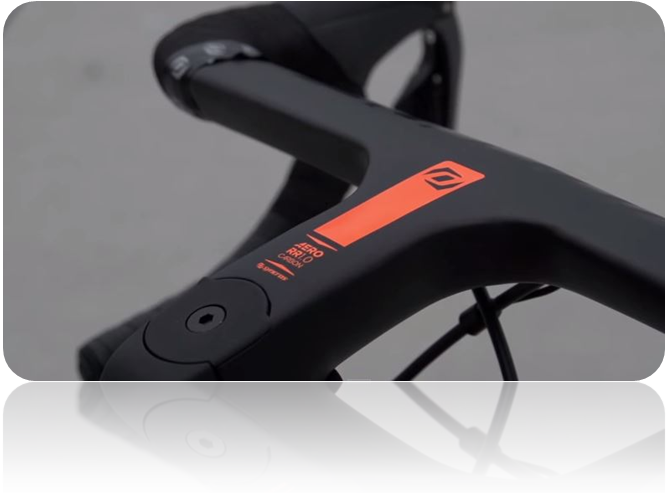
Integrated handlebar/stem combo like this one, found on
the Scott Foil save on aero drag, but must be sized
before you buy the bike. It cannot be adjusted and
is expensive to replace. |
Especially if you are considering a new
aero road bike like the Specialized Venge or the Trek Madone
9.x, bike sizing becomes crucial.
These new hyper-aerodynamic bikes
have highly
integrated aero components of fixed size, like the
handlebar/stem combo, with no range of adjustability.
You need to spec the handlebar,
stem size and rise before purchasing the bicycle.
This will ensure the right fit.
Considering the limited range of
adjustability found on these aero bikes and the extreme
cost (and wait time) to replace these highly proprietary
parts, bike sizing is no longer a question.
You must know the size needed or
pay the excruciating costs of poor comfort and
performance on a bike that is designed for pure bliss -
when dialed-in. |
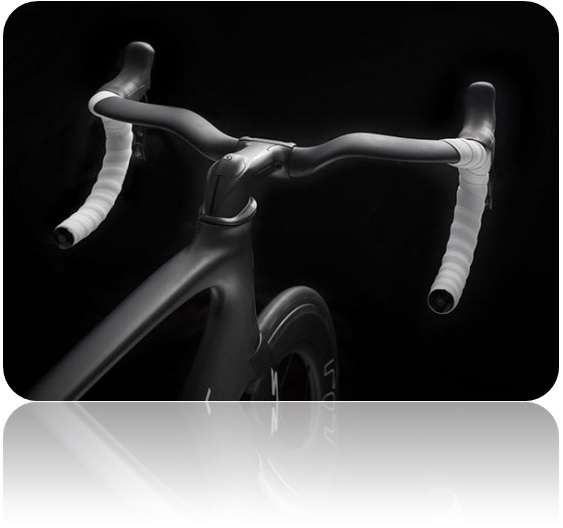
The Specialized Venge uses an integrated stem
combo that's proprietary. You must know the size at time
of purchase. |
| Triathletes also should consider
closely a bike sizing session before purchasing their
next Tri aero machine.
All bets are off when it comes to
Tri bike sizing: you may be a size Small in one brand
and a Medium in another and a 56 cm in yet another (more
on this further in the article).
Once manufacturers split off the
UCI Time Trial standards, the designers became free to
seek the most aero design with huge implications on the
sizing: there are no agreed-upon standards among
manufacturers engaged in a race to achieve the most
aerodynamic bike ever. |
 |
Even mountain bikers are now confronted
with a vast array of choices that makes sizing more difficult:
26, 27.5, 27.5+, 29, 29+, fatty 26. The wheel size choice
drives the geometry and sizing. Mountain bikes are sold first by
application, then by size. A Trail bike's geometry is different
from its Cross Country brethren and one can never perform the
job of the other quite as well. Full suspension versus hard tail
is also a consideration for geometry and sizing. Add the option
of having suspension forks with different travel range - which
has a direct impact on the geometry angles of the bike and its
handling- and you have such a range of options, you could shop
MTB geometries till the cows come home.
If you ride Trail on a Scott
Genius, you may ride a Large, but your Niner Jet9 RDO for
technical Cross Country maybe a Small and your Jamis Nemesis
27.5 for fast Cross Country may be a Medium.

Confused yet?
You should be. And that's a good sign. You
are engaged and you care about finding the ultimate performance
for your bike of choice.
WHAT IS BIKE SIZING AND WHY
SHOULD I DO IT?
Bike sizing is a process during which your ideal size, geometry and components sizing
(crank length, handlebar width, seatpost offset, etc.)
are determined. It gives you the information you need to make a
targeted decision. With the information from a bike sizing
session, you'll know what bike fits you the best, regardless of
brand and model, giving you the information needed to shop with
confidence. You can compare brands, models and specs to find the
bike that fits you right - not the one that's on sale or the
shop is pushing you to buy. It takes the uncertainty out of the bike
purchasing process and puts the power of in your hands, making
you an informed shopper.
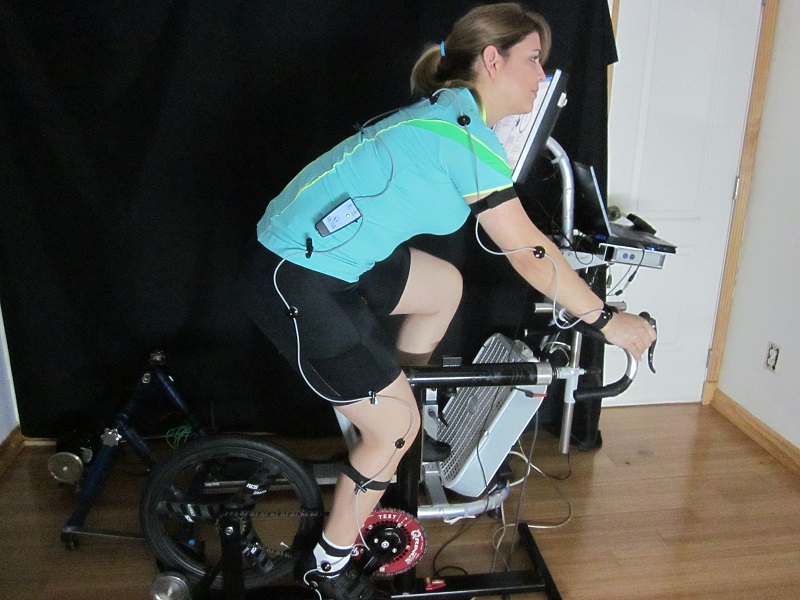
She is purchasing a new bike. Not sure of her size and
best geometry, she sought a bike sizing session.
Connected to the Retül wiring, the sizing and fitting
process helped find the right bike for her. |
Bike sizing is done aboard a technical
marvel
called a sizing bicycle. A typical sizing bicycle can
emulate an approximate geometry and size and give you a
quick fit range (say 52-54).
That was not good enough for us, so we
invented a sizing bike that replicates exactly any
bike, any geometry and any size - or make a new one for custom
geometry bike design.
It's an unparalled marvel of engineering from
the mind of our Master Bike Fitter that's our best ally into
helping you find the right bike.
Coupled with the Retül 3D motion
capture bike fitting technology, it's a powerful tool to test many
different bike parameters (in any combination) to arrive at the
ideal set up uniquely fit for you.
Bike sizing helps you find the best bicycle size and geometry
that fits to your body
type and limb characteristics. The length of your bones and the
ratio of one set to another is critical to your sizing.
It goes a step further. |
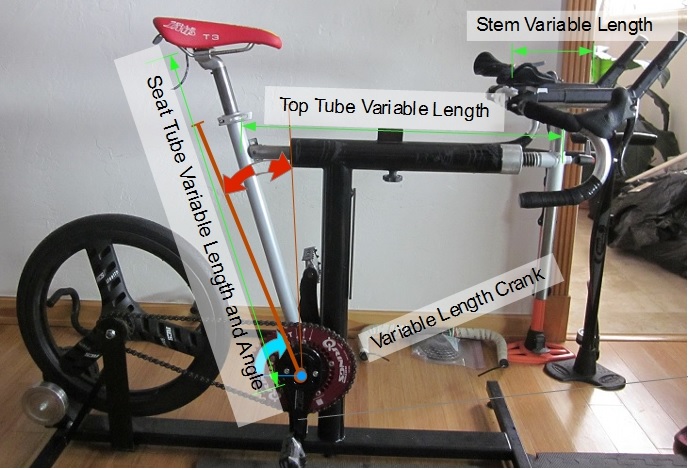
The sizing bike. I can emulate any size, any geometry, any bike
type: road, tri, mountain, etc. |
Bike sizing takes into account the
idiosyncrasies in your body to help you chose a bicycle that
doesn't conflict with any of your limitations. Your flexibility,
joints range of motion, current conditioning at key muscle
groups and injuries are taken into account to find a bicycle
geometry and size that's appropriate.
Your strengths are also taken into
consideration, to maximize your talent. Bike sizing taps
into your strengths, while protecting your limitations.
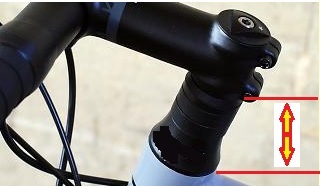
This many spacers mean that the stack in your the
bike geometry is not suitable to your flexibility |
For example:
You have a long torso and shorter
legs, your flexibility is marginal (can't touch your
toes) and you suffer from back pain.
Bike sizing can find the type of
geometry you need to be powerful and comfortable without
having a mountain of spacers under your stem. Too many
spacers weaken the steerer tube of your fork and may
fatigue it to failure over a period of time.
If you are strong with a developed
upper body, or you are a sprinter (even if it's just to
the next road sign), a frame with a higher stack
would be more suited to you. This would reduce the
length of the steerer tube exposed and the amount of
spacers needed under the stem - making it stronger and
safer.
With a bike sizing session, the
ideal geometry can be found for this special situation -
and many others. |
|
The result of a bike sizing session is a geometry
specifications sheet that will allow you to learn everything you need to know to buy a
bike with confidence.
It will equip you with the information
necessary to know your size, geometry and the size for critical components like the width of the handlebar, the size of the
cranks (often overlooked) and the need for (or not) an off-set
seatpost - all specific to you and your needs.
With the new complexities of the bicycle design (thanks to
sophisticated CAD systems and nanotechnology), this is vital
information.
Consumers have
been left behind by bicycle manufacturers who go deeper and
deeper in a world of ever-increasing sophistication and
proprietary customization. Geometry charts have become hard to read.
The
subtleties in their numbers can mean a big difference
between a bike that fits and one that never feels right.
Bike sizing
done while accounting for your strengths, weaknesses, body
ratios, preferences and application will help sift through all
the complexities and help you make an educated choice that
rewards you with the ride of a lifetime. |

A geometry specification sheet produced after a sizing
session for a road bike. This customer chose a Jamis
Zenith Comp and wanted to make sure of the size. We
found a 0 setback post is needed instead of the OEM
setback. It can be swapped out at the bike shop during
the purchase.
Click to enlarge. |
DO YOU KNOW YOUR SIZE?
Most cyclists think they know their size. At one point of your
cycling life, you have been told your size by a shop employee or an expert. "You
are a 52". That information stuck and became your
sizing identity. You carried that sizing ID with you and it was
your guidance through several past purchases. But, suddenly,
today, it doesn't apply anymore.
The complexity of bike design has increased dramatically
in the last few years - making sizing more complex. Long
gone are the days of the traditional (AKA standard) geometry
sizing, where a 52 cm bike measured exactly 52 cm at the top tube
and seat tube. Today, a size 52 cm could be a sloping geometry
and have a 55 cm top tube; or could be a compact geometry and
have a 53 cm top
tube. And some manufacturers still make traditional geometries too,
adding to the confusion of sizing.
 Click the image for full size. May need to use
CTRL+mouse scroll to enlarge.
Click the image for full size. May need to use
CTRL+mouse scroll to enlarge.
Look at the example above. Here we look at a comparison between
a 52-53cm size in 3 popular and prestigious brands, each with
their interpretation of sizing and geometry.
When you look at Colnago's bikes, you see two options: 53
Traditional and 52
Sloping. OK, so that should be just about your size, right?
Nope.
Look closely. The top tube of a 53 Traditional (measurement O)
is 53.7 cm, while it's 55 cm on a 52 Sloping. Big difference.
The operative word here is traditional Vs. sloping.
Not only the size, but the geometry type are
critical to your sizing.
Compare now to Pinarello's sloping geometry. A 53's top tube
(measurement L) is 54.5cm. And Giant's top tube is 53.5 cm for a
Small in a compact.
Now you have learned that the OEM stated
size is not the only driving parameter to your sizing, but
also the geometry type. We have encountered 3 geometry
types just in this example: Traditional, Sloping
and Compact. Are there more? You betcha. There are
semi-sloping, quasi-compact and near-traditional geometries -
just to mention some - and they reflect the design philosophy of
a manufacturer. But they hardly ever mentioned in the sizing
chart by type, because the sizing chart itself reveals that to
you. That's according to the OEM. Does it help you?
If you think this is confusing, welcome to
club. Most cyclists are.
Blame it on the competition among manufacturers. It drives them
to design the ultimate bike, making geometry and sizing the
hallmark of their performance. It's nightmare for you to figure
out, but the ultimate bliss when you ride the
perfect bike.
Having more choices is never bad. Making the right choice
is the big issue here. Get it wrong and it could cost
you dearly.
That's when bike sizing really pays for itself.
SALES
To add to the complexity of choosing the right size, there are also
considerations due to the sales process.
|
Unfortunately, bike shops will try and sell what they need to
move off the floor. Some bike shop employees are biased by their
own experience and can't transcend it to suggest something else.
They know what they ride (or would like to) and recommend it
regardless of your needs and attempts at communicating your
expectations.
Not all
bike shops operate that way. We know and work with many
reputable shops that go to great lengths to ensure the customer
is getting the right size and geometry. Many send us their
customers to have a sizing session with us.
Also, not all bikes are hard to size.
But it happens. How often do we hear from
fellow riders that they were sold the wrong bike? What a
nightmare that is, especially if you bought the bike of your
dreams!
In our bike fitting practice, we have seen our fair share of
riders who had the wrong size bike. It's never pleasant to have
to give the heart-breaking news.
It happens mostly with cyclists who are at the opposite ends of
the anthropomorphical extremes: very tall or very short. This
means that we see a disproportionate amount of women in the
wrong size bike. We talk about it in this
women-specific
article.
Sometimes, it happens with medium-stature
riders, who are on the cusp of two geometries. They were encouraged into the wrong one
and now they struggle with a good fit and handling.
And, often, the cyclist itself is the
culprit: couldn't resist the sale, even when the bike shop
warned about the sizing being incorrect. The power of the bling
was too much.
And even if you were not sold the wrong size, you might have the
wrong geometry. If you have that nagging feeling that you never
feel 100% on your bike, it could be the geometry in combination
with the sizing of your components. |
|

|
WHEN A
SALE IS NOT A GOOD DEAL:
Sometimes cyclists can be
their own
worst enemy.
Riders can be swayed by a
deal too good to pass up, thinking the bike will
fit, even if it's not the right size.
Don't buy a bike
just because of
a good deal.
It may look good standing; it may have
great components. But when you ride it..? Not so good. |
|
| HOW BIKES ARE SIZED
OEM bikes come with the best combination of sizing,
geometry and components sizing that fits the largest
average of humans possible. That combo is driven by the
95-percentile human: 5'8" and about 160 lb with specific
body ratios.
That may work for some people. But definitely not
everyone. And most often than not, you know what happens
when you try to make everyone happy: no one really is.
Add to this the complexities of UCI regulations,
limiting certain aspects of a bicycle design. The
unintended consequences of UCI rules produced (in this
order) a number of bicycle design monstrosities,
especially for aero models, followed by more regulations to
prevent them, restricting bike design too much, further
followed by a clean break
between the UCI and the main Triathlon governing bodies,
which led to the cowboy days of aero bikes
design. Even though Tri bike design is positively
moving in the right direction, as of now, the design
variations are so wild, that sizing has become nearly
impossible even for the most sophisticated bike shops. |
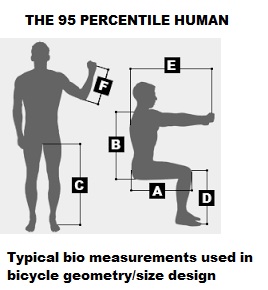 |
| Example.
Let's look at the geometry
chart of a couple of popular aero bike: the Specialized Shiv and the Scott Plasma.
When looking at the
reach
and stack measurements, it becomes obvious that a
Small Shiv closely compares to a Medium
Plasma. The same goes for the XS Shiv and S Plasma.
If you were shopping for a bike and you walked first
into a Scott dealer, and were told you were a Medium, then you'd go to a Specialized
dealer thinking you'd need a Medium. And you'd be wrong.
Who would catch that mistake?
That's our job. The job of the bike fitter. |
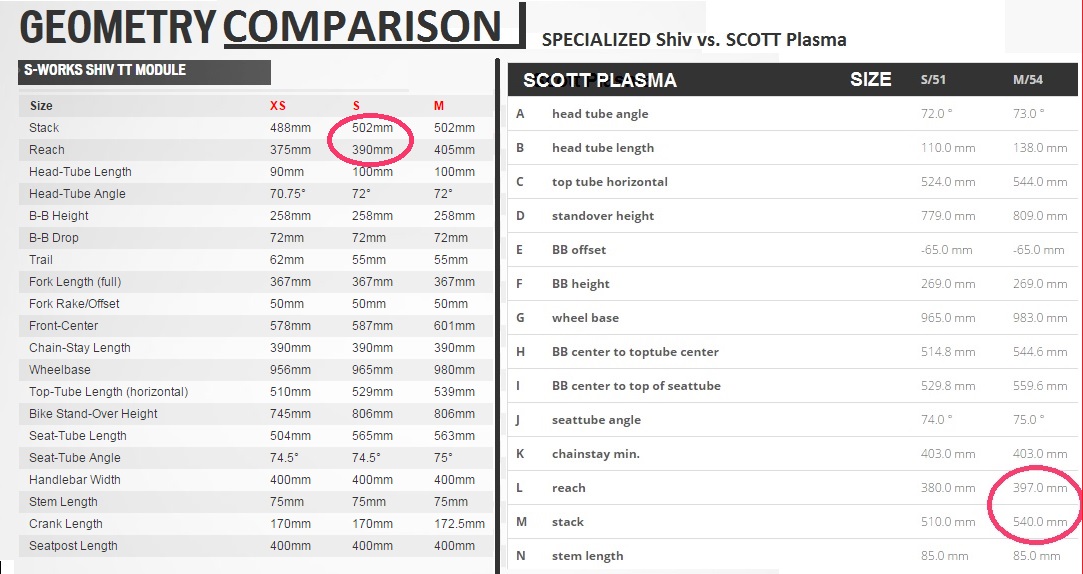 |
THE IMPORTANCE OF THE SEAT TUBE
ANGLE
Do you know what is the right crank length for you? Let me
guess, you ride a 172.5 on the road and 175 on the mountain
bike. But is it right for you?
Crank length is closely related to your femur (the bone in your
thighs) and your tibia (the bone in your shins) length and their
ratio. But the length of the crank plays a much more intimate dance
with the seat tube angle of the bike. A variation of 1 deg at
the seat tube causes the seat to move back or forward 15mm
on a 52 frame. That's big. A crank varies in length just 2.5mm (from a 172.5 to a 170 or 175)
in either direction. See how a important is this combination?
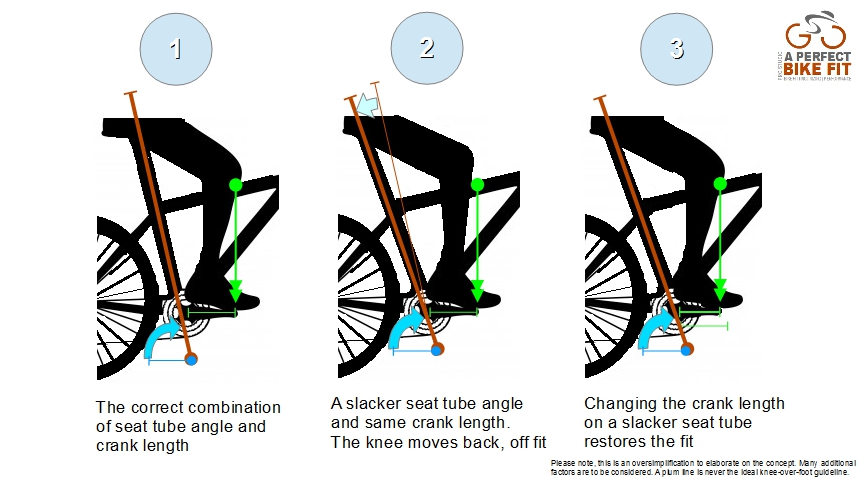
Seat tube angles vary quite widely. You might have heard people
saying they like a steep geometry or -the opposite-
slack tubes. What does it mean?
The angle of the seat tube and head tube influence greatly the
riding character of a bike. Steeper bikes (bigger angles at the
seat and head tube) tend to be more maneuverable and twitchy
(with exceptions) and usually are race-oriented. The opposite is
true for slacker bikes, with more relaxed geometries, better
suited for endurance and typical amateur riding. For a brief and
brilliant explanation of bicycle frame geometry and its effects
on riding qualities, read
here.
As you select one geometry over another, the choice of
components, especially the crank length, becomes an integral
part of the process. Yet, no one thinks about it or has ever
bothered telling you before. The wrong length crank will leave
you with the feeling that you can never give it your all, even
if fit properly.
What's the solution?
BIKE SIZING
Bike sizing takes the guess work out of the
bike size, geometry and
components sizing.
Let's look at this again.
What is sizing?
Sizing is the process of being fit into a sizing bicycles to
determine the right size, geometry and size of components (like
cranks, handlebars, stems and seatposts). It helps you
determine the best combination of seat tube angles, crank
length, handlebar width, height of the head tube, and so much
more.
It's done using a sizing bike, a stationary bike that can change shape in
every direction imaginable and has variable length cranks.
| With a fit bike is possible to simulate any
geometry and size of any bike.
Typically, you'll go to a sizing session with a list
of 2-3 bikes you are considering. The geometry of each
bike is set up on the sizing bike to OEM specs and
individual components are sized.
There is also a process where we
can start from scratch and just design a bike geometry
around you - ideal for custom geometries. You provide
information on what you want to the bike to do (or not
do) and the application (more on this later) and
we work out the set up and test a several options until
optimal.
A Retül 3D dynamic motion capture bike fit is done to
asses how successfully you can integrate with each
size/geometry and how well you respond to components'
size changes.
Adjustments to the sizing bike are made: stem
length, handlebar height, seat height/fwd/aft are moved
until you are in a biomechanically neutral position - just
like during a regular bike fit. The best position
is sought within the allowable range of each bicycle's
specific geometry/size.
|
 |
Most importantly, crank length is tested at this
stage. If needed, the length of the crank is changed
within your biomechanical range. This is where it's found
whether you and the bike are a match or not.
If biomechanics parameters don't line up as they
should, it's time to move on to another geometry/size.

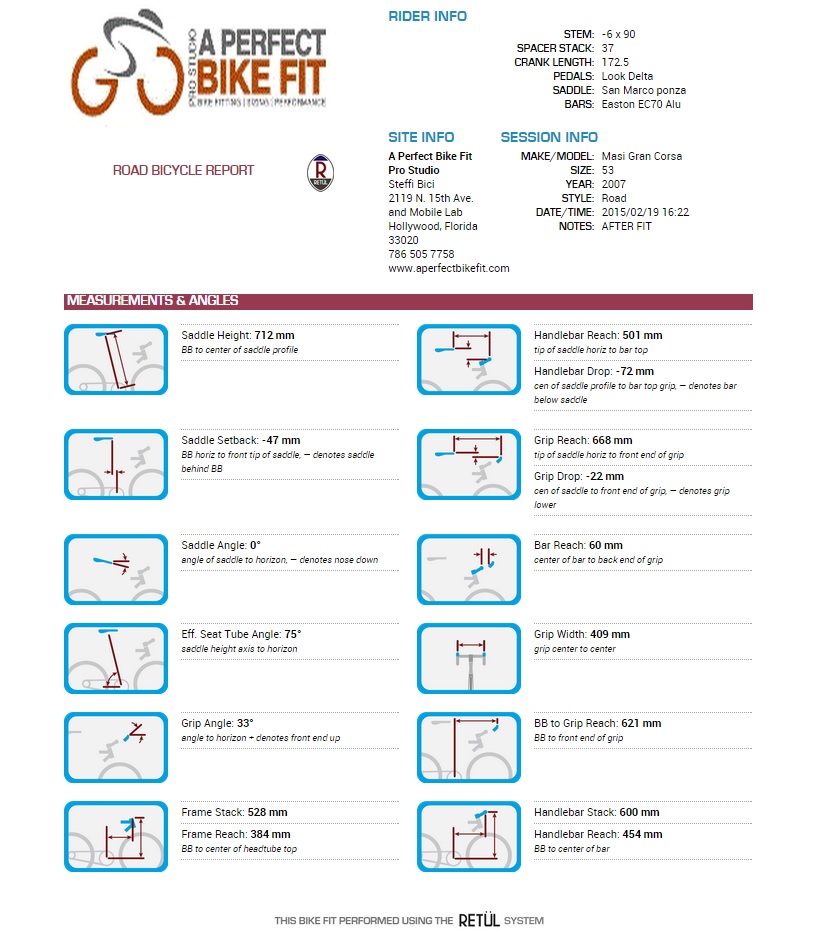
The geometry spec sheet.
The result of Retül's bike digitization process after
the fit session. It's unique to Retül, no other fit
system uses a digital, 4 lasers, CAD methodology to take
the measurements off the bike (in this case the sizing
bike). Most (if not all) other bike fitting systems take
measurements manually, introducing large human errors. |
This process is repeated for each bike size/geometry/component
spec. Retül's motion data for each capture gives a skilled
fitter the information needed to find your optimal settings.
A fitter can see when you move in harmony with your equipment.
The Retül dynamic motion capture system with 1mm of accuracy
helps the fitter tell when subtle-most movements are
out of synch and then adjusts the sizing bike.
In our practice, we work in a 2-way communication with our
cyclists, so changes are made that not only look good on the
data screen, but also feel good to you.
After we arrive at a sizing bike set up that looks and feels
good, we collect the measurements with a system unique to Retül.
The final settings on the sizing bike are digitized with a Retül process called Zin.
The Zin is a laser 3D CAD wand that traces the bike's components
at key locations and records all key measurements on the sizing
bike. It generates a geometry sheet with loads of information like crank
length, handlebar reach, stack and width; the height and setback of the saddle, etc.
It's a wealth of knowledge that is provided to you in a PDF file
you can view on your smart phone.
And, more importantly, give us the key
measurements by which we can help you select the right bicycle
size and geometry and even design a custom geometry
specific to you using the Dream Bike software of
our own design. Go here to see about
custom geometry design.
For riders looking to purchase beautiful bikes with integrated
components, like the Specialized Venge, Trek Madone,
Scott Foil or Look 795, etc. bike sizing is very important because it
helps determine the size of the integrated stem/handlebar combo.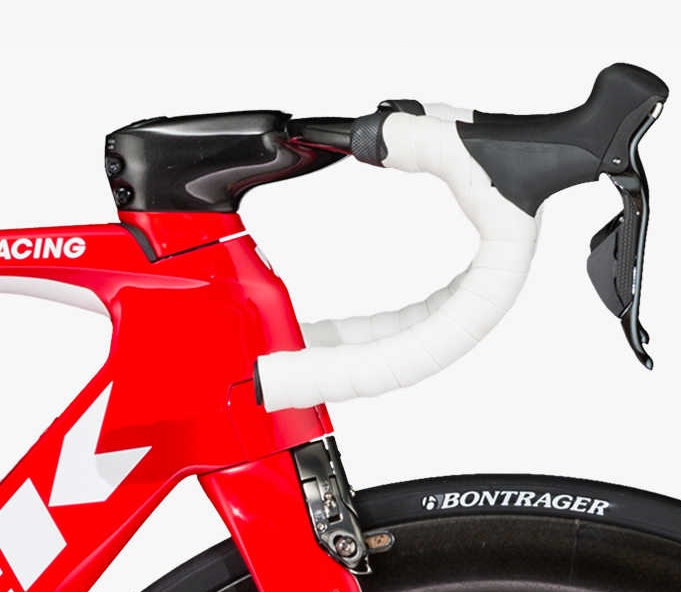
These beautiful and extreme aero components have a major drawback:
they cannot be adjusted and are highly proprietary. If you bought a bike with a 100mm 42 cm
stem/bar combo (standard stock on sizes 52-56), and you ride it, you are stuck with it,
or, you need to spend $1,000s to replace it.
Bike sizing will help you find the right
handlebar/stem combo size to achieve the right fit.
Don't ride out of the store with the stock set up. The bike shop
will swap out the parts for the right ones before
the final sale. With the information from bike sizing, you'll
know exactly what bar/stem combo to ask for. |
|
A POWERFUL BIKE SHOPPING TOOL
Bike sizing will give the most important set of measurements of
all. Bike design's dirty little secret:
reach and stack.
That's what you are looking for
in a new bike. It makes you the best informed shopper.
And this is were things become interesting.
Reach and stack are the only two truly
standardized measurement parameters of any bike.
They essentially standardize the
measurements of how long and how tall the top tube is in
comparison to the
bottom bracket. It's universal.
Reach is related to top tube length normalized
off the seat tube angle (unlike the top tube
length). Stack is related to the height of the
head tube - making it a big consideration for
cyclists with back issues or Big & Tall and Small &
Short
riders. |
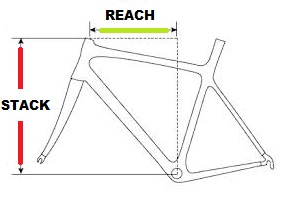 |
Go back to the sizing chart above and look at reach and stack
measurements for all geometries. Now you go: Ah! I see the big
difference among geometries, given the same size. A Colnago 52S
stack is 565mm on a sloping geometry, but only 530mm for a 53
traditional. A whopping difference of 35mm. Clearly, something
to consider if you have back issues...
Unfortunately, no one ever tells you: you are this reach
and this stack. And so, sizing becomes the
necessary process to determine these 2 key parameters so you can
compare bikes of many different manufacturers.
Given 3 parameters, reach, stack and seat
tube angle, it's possible to draw a bicycle geometry - with
the top tube and standover clearance helping complete the
process that drives the purchase. It gets more complicated with
handling characteristics driven by head tube angle and fork rake
and fork trail, wheel base, etc. But those parameters are
decided for you by the manufacturers striking the best balance
and are not a variable option for a typical consumer
during the off-the-shelf bike buying process - they are,
however, during the custom
geometry design process.
Armed with the information of reach and stack and your ideal
crank length for each geometry and integrated components size
(bar/stem combos), you can now begin shopping
as an educated consumer. You can go to an OEM's web site
and custom build the bike of your dreams. You can engage your bike shop
in an intelligent conversation that will end up with the best
ride of you life.
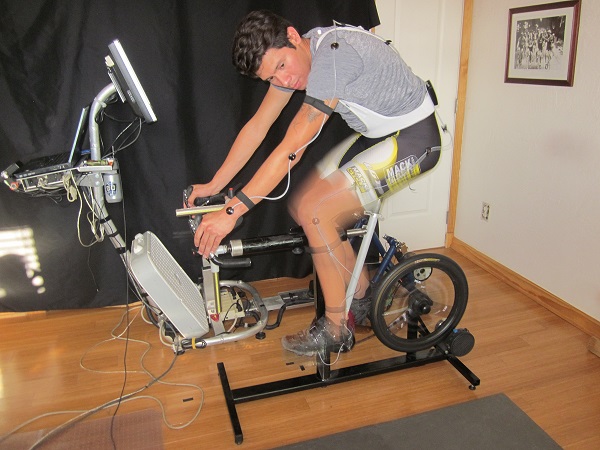
This cyclist is wired up with the Retül system, and sized
to help find a geometry that would prevent an unhealthy
back curvature |
THE NEXT STEP: BIKE FIT VS SIZING
A proper bike sizing session should always be followed by the
final fitting on the actual bike you purchase.
Transferring the measurements from the sizing bike to your new
bike is not very effective for most applications.
The sizing bike
is good at getting you measured up, but it's not great at
getting you optimized in your actual bike. Sizing bikes come
equipped with a set of customizable parts that do the best at
emulating the average component. They are perfect for the sizing
process, but not for the optimization needed to do a bike fit
into your actual bike.
There are a number of
nuances that cannot be simulated with the sizing bike.
This is the reason why you should avoid getting a bike fit
from an establishment that relies only on bike sizing technology
for the actual bike fit - that is, it fits you on the sizing bike
and transfers the measurements to your bike, never working with
you while aboard your actual bicycle. |
| The gap between a sizing fit and a bike fit is very
large in term of performance optimization and pain
prevention/management/recovery.
For
example, the Q-Factor (the distance between you L and R foot
when clipped in the pedals) varies greatly by crank brand and
model.
This affects your knee tracking
and health. The sizing bike uses a
variable length crank that's standard to all sizing bicycles
(there is only one made, by Purely Custom). This unique
crank is different in Q-Factor from many
manufacturers. It wasn't designed for knee tracking alignment,
but crank arm length adjustment.
The proper position of your cleats
to align your knees depends on the Q-Factor. It's
important that the final fit is done on your own bike,
not the sizing rig, so the knee tracking is aligned to
your actual bike.
Other nuances are the position and
alignment of the shifter hoods/grips, which is paramount for hands
comfort.
Also, the sweep, reach and drop of the
handlebar is vital for the correct wrist and arm position, as
well as back
comfort.
These things cannot be accurately simulated by a sizing
bike unless it's an actual clone of your own bike.
That means, same handlebars, same crank, same
stem, same seatpost, same saddle, same pedals, etc.
|
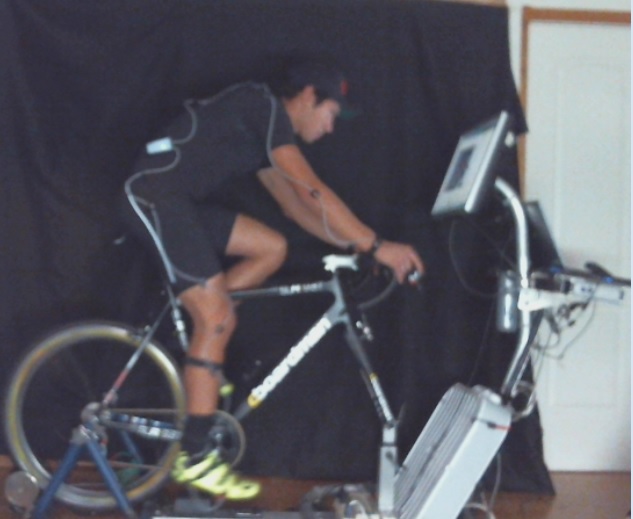
The final bike fitting session produced the correct back
angle for the customer being sized in the picture above.
He had been frustrated by back pain before. Sizing
helped him find the right bike. Fitting has dialed-in
his position for optimal comfort and performance |
With so many OEM components variations, no
sizing bike can possibly do that. Just stocking all variations
of handlebars would be a nightmare. And so, it's not done by any
system or anyone.
That's when being first sized and then
fitted with a process like the one we employ becomes paramount.
In our practice, we approach
bike sizing as a 2-step process:
1) Day 1: Bike sizing on the studio size bike. Generate
geometry sheets.
2) Day 2: Bike fitting on the actual bike.
Small nuances make a big difference in the
comfort and performance of a rider. This is the process that's proven to produce the most success.
APPLICATION:
Even if you know the right size and right
geometry and the size of all your components, one consideration
remains to be addressed: the application.
Application is what you use the bike for.
What do you want your bike to do for you?
What are your expectations of its performance in the typical use
and its environment?
I bet you never asked that question when you
went to a bike store. These are the questions you need to ask!
You probably assumed that most bikes can
do the job with some adjustments - or rely on the bike
shop/internet advise to tell you what bike would be right for
you.
But that's not true. That's an important
question to ask: can this bike satisfy my needs?
|
We recently worked with a customer who
purchased a very high-end bike for his 50th birthday. "I went
to the store and looked for the best bike. I wanted to splurge
on myself and buy me something really nice." He walked out
of the bike shop with a Pinarello Dogma with carbon wheels and
electronic groupset.
Nice bike, you think.
Indeed. But unfortunately, not the right bike
for him.
You see, this customer rides 2-3 times a week
on mostly pot hole-riddled roads. He is no young punk anymore
and his flexibility is not what it used to be. Neither is his
belly. He is your typical cyclists who rides for health and
fitness. And he likes to go long distance. 60 miles is nothing
to him.
Is a stiff race bike with even stiffer wheels
the right bike for him?
Probably not. But when he said: "I want a nice bike."
he assumed that nice meant expensive (which the bike shop
clued on - can't blame them) and that meant also comfortable and adjustable
and the best for his use. A few rides in, his aching back made
him realize what had happened.
|
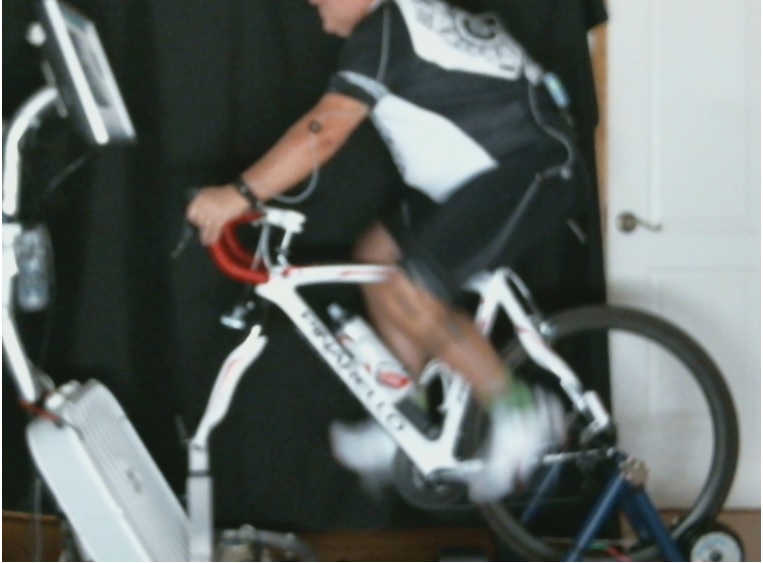
As beautiful as it may be,
a high-end race bike may not be the best choice for
your riding. Price doesn't often equal comfort. |
His mistake is not uncommon. And so we see a
score of people with high-end race bikes struggling to fit their
non-racing bodies in them and hoping for relief after the expenditure of
a lifetime. A bike fit can do wonders for comfort. But can't
change the riding quality of a bike.
PURCHASING CONSULT
A bike sizing session doesn't end at the
right size and geometry. It continues with the right bike for
the job. And that's why good bike shops send us customers: they
want their customers to be satisfied with the shop by helping
them buying the right bike.
We spend considerable time talking with our
customers about their goals in bicycle riding and fitness. We
spend a considerable amount of time in studying your body
joints, flexibility, range of motion, strength and balance. We
talk about injuries and pains experienced in the past or
recently in your past and current bikes. This tells us what's
possible and what's not.
| For example, we wouldn't
recommend a Look 795 Aerolight for a middle-aged
cyclist, with average flexibility, who likes to ride
with the weekend group for health, fitness and fun.
The Look 795 has a very low stack
(i.e. very low head tube) and an aero stem integrated in
the top tube with very little range for rise. This may
be the
perfect bike for a hyper-flexible, young racer; but
hell-on-wheels for a baby boomer.
The fun part of riding would fly
right out of the window for the cyclist in our example.
Eventually the health and fitness
would too, as back pain sets in. Not because this is a
bad bicycle. On the contrary. It's a great bicycle at
what it does: beautiful, slick and race-oriented. But
not the right bicycle for our fictitious, cyclist in
this example. |
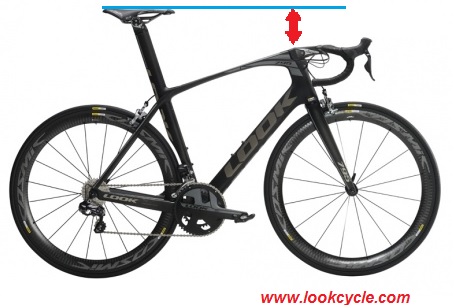
Beautiful, slick, elegant. This is a race rig. Awesome
at its job. But not the bike for a baby boomer. |
Bike sizing studies you in your
application and helps you choose not
just the right geometry and size, but the right bike.
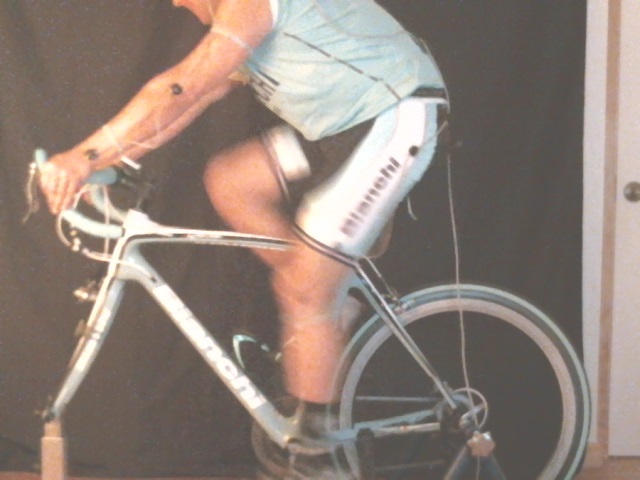
Even with a good bike fit
result as seen here, this cyclist struggled with the
stiff riding characteristics of a nice Bianchi Infinito
C2C. |
IS CARBON
ALL THERE IS? Most bikes
these days are carbon. Carbon
bikes are wonderful.
Light, elegant, complex in
shapes... Masterfully designed on CAD systems and
expertly executed with nano technology that aligns just
the right amount of molecules in the right place.
There are so many variations of
carbon with different characteristics of stiffness and
compliance.
But because of the expensive
manufacturing of carbon (due to complex moulds and large
vacuum autoclaves) there are fewer options in the choice
of geometry.
So, most carbon bikes are race oriented, with small variations from
what the Pros ride. There are exceptions, true. But the
lay of the land in carbon bikes has a strong racing
pedigree.
This makes the question of
application even more relevant.
A race bike - an nice, expensive
bike - is a stiff rig, designed for speed but not
comfort.
|
| Some fondo carbon bikes are
designed for endurance.
They use more compliant carbon
and even have vibration absorption dampening inserts to
aid with reducing vibration transfer from the terrain.
Specialized uses Zertz inserts at
several key locations.
Trek introduced dampening modules
in its Madone line at the junction of the seatpost and
top tube.
They are a strong attempt at
improving the riding qualities of carbon bike and
bringing comfort to a material designed for strength.
But the truth remains, most carbon
bikes tend to have a harsh, stiff ride quality, not well
suited to aging cyclists trying to increase mileage for
cardiovascular health. |
 |
That's why we are seeing a return of
metallurgy in cycling. Steel and Titanium are making a roaring
comeback because they are more forgiving materials and can
address the comfort of our ever-growing middle-aged cycling
community.
Steel is real. And rides like no other
material. The warmth, the comfort, the smoothness... Buttery.
That's how some would describe the riding quality of steel.
|
Many of us remember that from the old days
when steel was the only option. There is a weight penalty; sure.
But if you are not trying to set a new land speed record, I'd
think that your comfort would be more important.
Ti is light and beautiful and very forgiving
in its vibrations transfer. You can build a light weight bike
that's comfortable to ride.
These materials fell out of favor when carbon
pushed the limits in frame weight and design. But they are
coming back because their riding qualities and durability can stand the test of time.
|
 |
Do you know if you could be a good candidate
for a Ti or Steel bike? Is your application more suited
for a metal or carbon bike? Would a
custom geometry be an option
appealing to you? What's your application?
|
Because a reputable bike fitting/sizing
studio like ours is not invested in the sale, a bike sizing
session could be the best unbiased advise you could ever get.
And maybe - just maybe- it will open your
world to a new set of choices; ones you didn't think about; the right options for you.
Don't make a big purchase mistake. Get sized.
|
|

|
MORE INFO:
See our sizing and pricing
options here |
|
OUR BELIEF:
"You don't have to be a Pro to get a bike fit. Everyone who
climbs into a bike deserves to have a great experience,
regardless of their fitness, expertise or equipment level."
A Perfect Bike Fit Pro Studio
Love your ride. Get a bike fit.